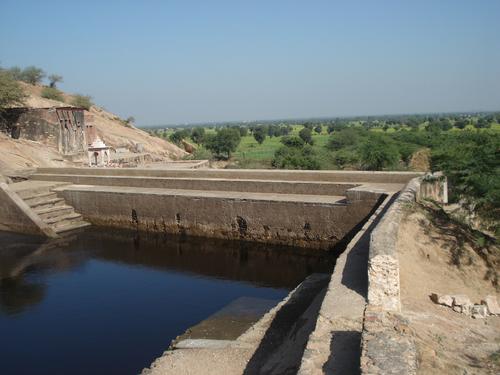Macrocatchment water harvesting
Macrocatchment water harvesting (MacroWH) systems usually consist of four components: the catchment area, the runoff conveyance system, the storage system and the application area. In the catchment area, rainwater runoff is collected from compacted surfaces, including hillsides, roads, rocky areas, open rangelands, cultivated and uncultivated land and natural slopes. Most MacroWH practices have a catchment area of less than 2 ha, in some cases however runoff is collected from catchments as large as 200 ha. The runoff is conveyed through overland, rill, gully or channel flow and either diverted onto cultivated fields (where water is stored in the soil) or into specifically designed storage facilities. Where concentrated runoff is directly diverted to fields, the application area is identical with the storage area, as plants can directly use the accumulated soil water. The application or cropping area is either terraced or located in flat terrain. The ratio of the catchment to the application area (usually cultivated) varies between 10:1 and 100:1. In the second case, a great variety of designed storage systems keep the water until it is used either adjacent to the storage facilities or further away (involving a conveyance system). The classification of technologies into FloodWH or MacroWH is not always straightforward. It depends on the catchment size (FloodWH > MacroWH), the size of rainfall event (FloodWH > MacroWH) and concentration/size of runoff which is tapped (FloodWH harvest from the channel flow, MacroWH collects sheet and rill flow and short-distance channel flow). The harvested water is mainly used for crop and livestock production but also for domestic use, depending on the quantity and quality.
Water storage and purpose
Water stored in the soil is directly used for plant and crop growth prolonging the growing season and bridging the dry spells allowing to produce crops and yields without demanding irrigation systems. Designed storage facilities cover a broad range of open or closed structures. Open storage include farm ponds and different types of dams (often earth dams). Closed structures can be groundwater dams or above and below-ground tanks or reservoirs. Such storage structures are often characterized by multipurpose use, prioritizing domestic and livestock consumption. During dry spells, sometimes the water may be used for supplementary irrigation.
Most common technologies
These are: hillside runoff / conduit systems; large semi-circular or trapezoidal bunds (earth or stone); road runoff systemsand open surface water storage in dams,ponds and pans; groundwater dams (subsurface, sand and percolation dams); above- or below-ground tanks (cisterns); horizontal and injection wells.
Applicability
MacroWH practices are applicable in arid, semi-arid to sub-humid zones where it is necessary to store water to bridge the dry season or to mitigate the impact of dry spells. They are often situated in natural or man-made depressions, or even in ephemeral riverbeds. MacroWH is required in areas with long dry periods and where rainfall fluctuates widely over time. Further information about the applicability can be found here.
(Mekdaschi & Liniger 2013)
Read more about themain characteristics, benefits and disadvantages
